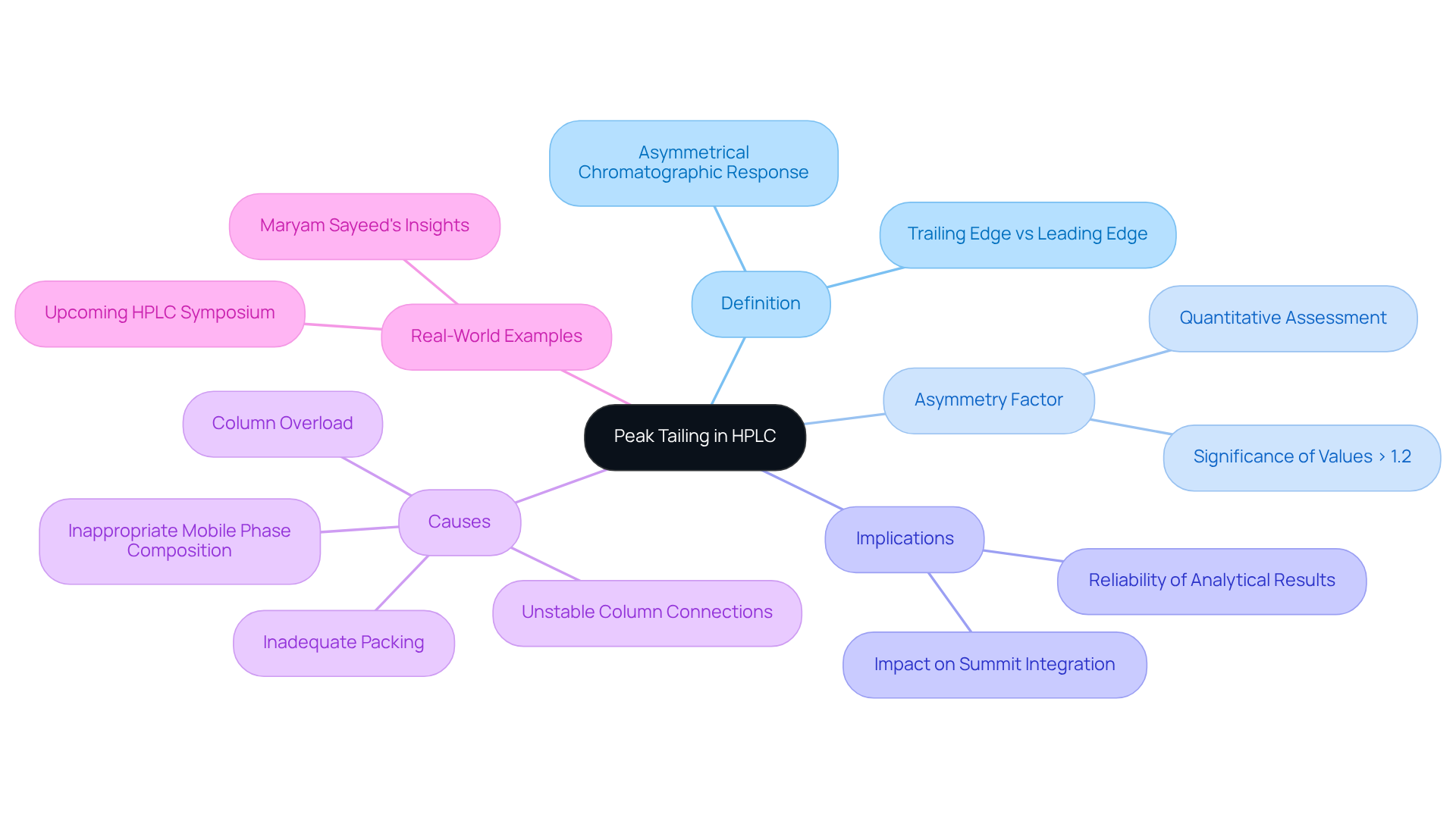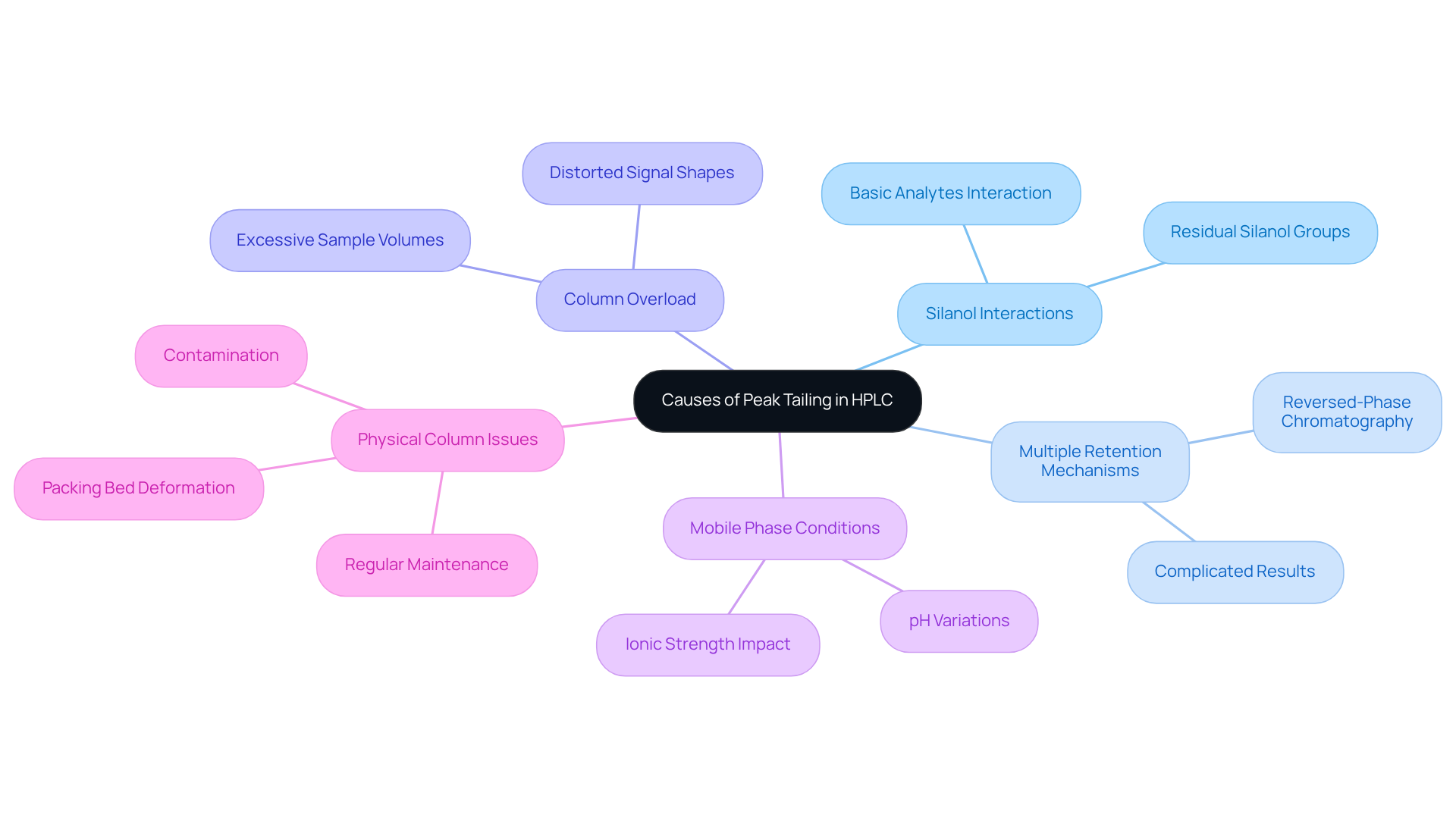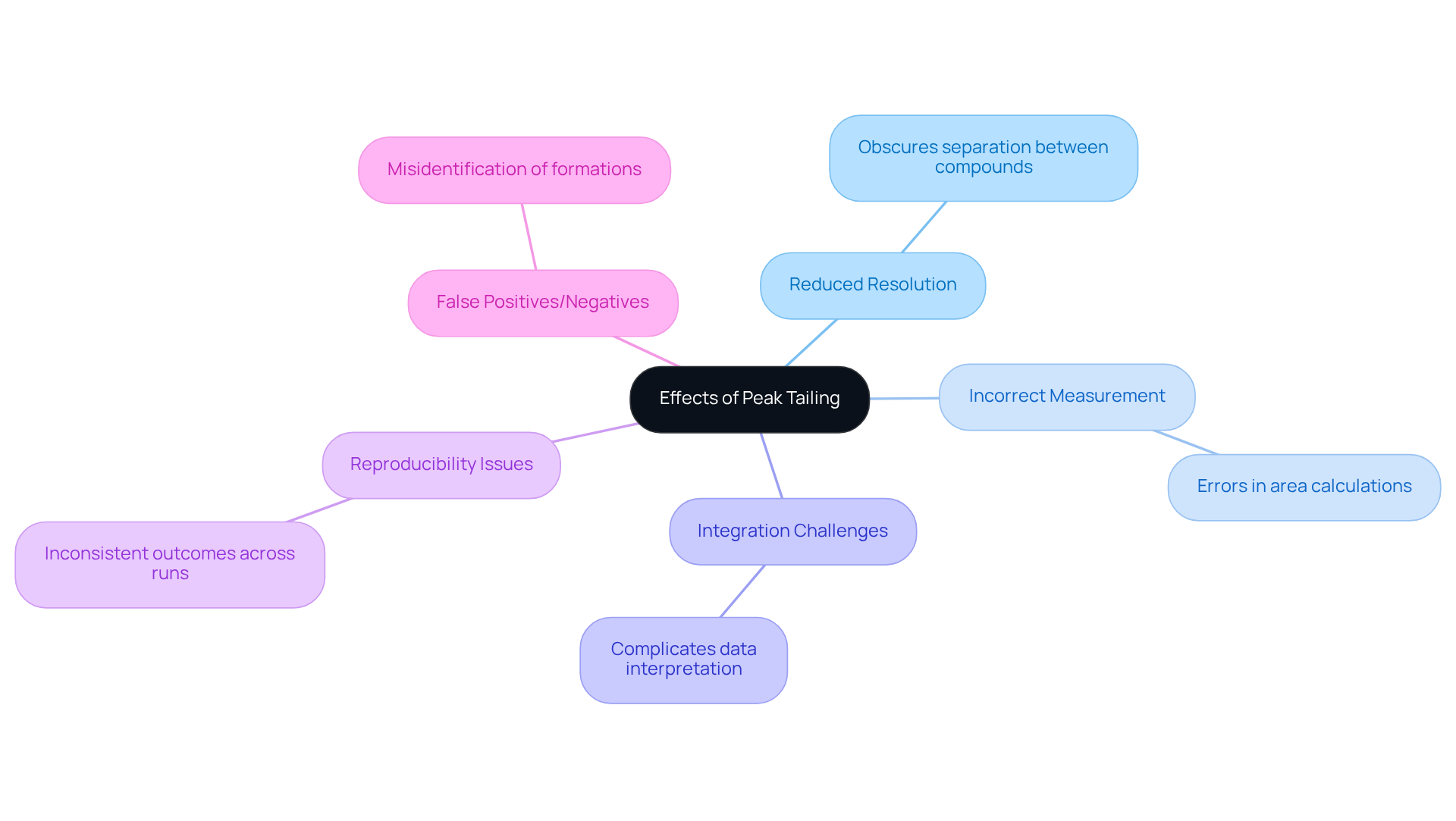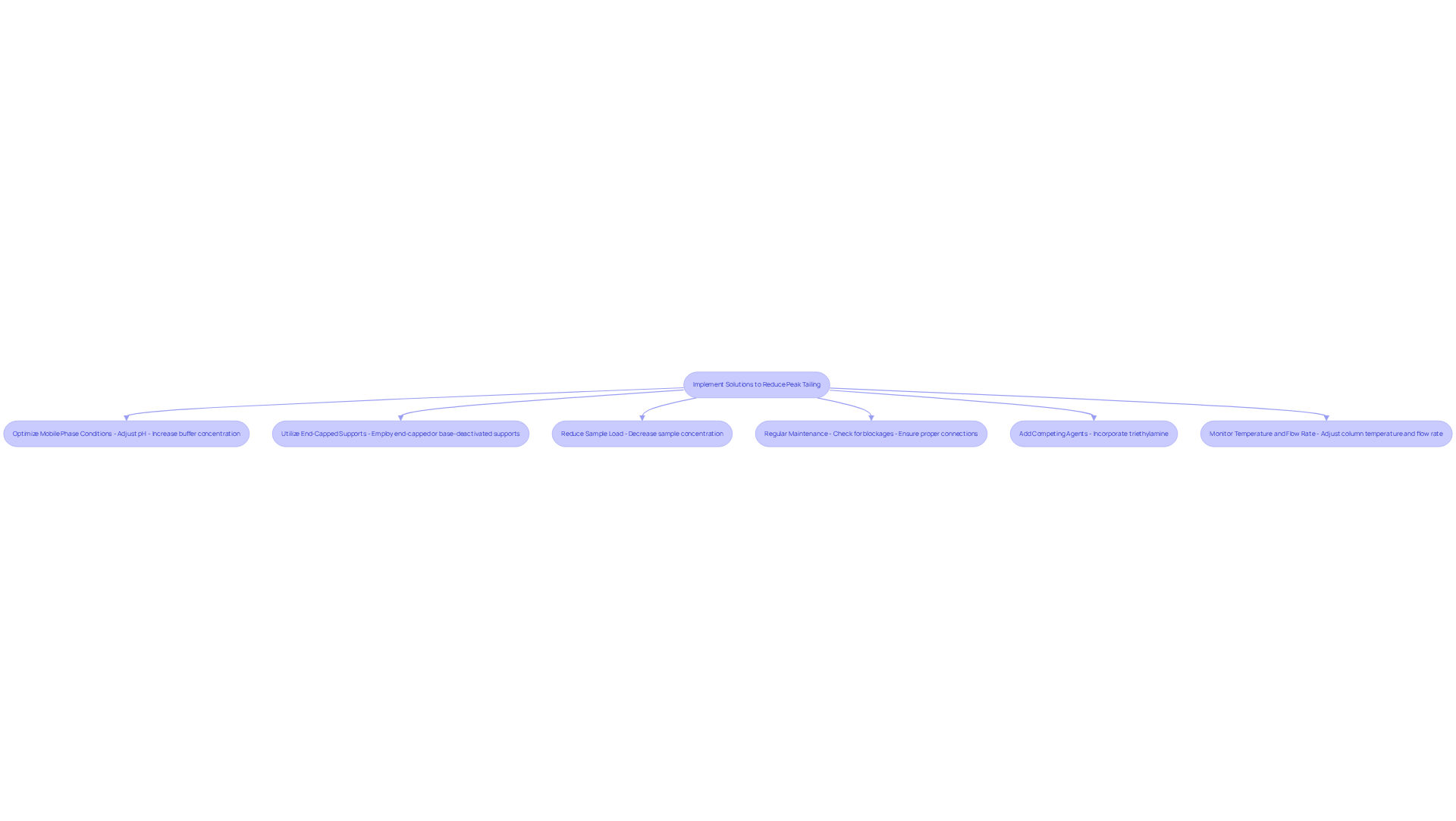Overview
This article delves into the causes, effects, and solutions related to peak tailing in High-Performance Liquid Chromatography (HPLC), a critical issue in analytical chemistry. Peak tailing arises from factors such as silanol interactions and column overload, which can severely compromise analytical results. The negative impact of peak tailing is profound, as it reduces resolution and leads to measurement inaccuracies that can misinform research conclusions.
Therefore, it is imperative to implement effective strategies to mitigate this phenomenon. The following steps are essential in enhancing chromatographic outcomes:
- Optimizing mobile phase conditions
- Ensuring regular maintenance of chromatographic systems
By addressing peak tailing, laboratories can significantly improve the reliability of their analytical results, thereby reinforcing the importance of high-quality scientific instruments in achieving accurate and reproducible data.
Introduction
Understanding peak tailing in High-Performance Liquid Chromatography (HPLC) is essential for ensuring precise analytical results. This phenomenon, marked by asymmetrical chromatographic responses, can severely compromise data integrity if not effectively addressed.
As laboratories aim for unparalleled precision, the challenge lies in pinpointing the root causes of peak tailing—spanning from silanol interactions to column overload—and implementing targeted solutions to mitigate its effects.
How can chromatographers refine their methodologies to surmount these challenges and enhance the reliability of their analyses?
Define Peak Tailing in HPLC
Peak distortion in High-Performance Liquid Chromatography (HPLC) manifests as an asymmetrical chromatographic response, where the trailing edge extends beyond the leading edge. This phenomenon is quantitatively assessed using the asymmetry factor (As), with values exceeding 1.2 indicating significant skew. Such trailing complicates summit integration and measurement, ultimately jeopardizing the reliability of analytical results.
Identifying and addressing maximum tailing peak is essential for chromatographers, as it often signals underlying issues within the chromatographic system or methodology employed. Recent studies underscore the , illustrating that effective management of this concern is vital for maintaining the integrity of analytical processes.
For instance, Maryam Sayeed, Product Manager at Phenomenex, noted that laboratories conducting LC analysis may face challenges in their results due to unstable column connections. Real-world scenarios further illustrate how maximum separation may arise from factors such as column overload, inadequate packing, or inappropriate mobile phase composition, emphasizing the necessity for diligent system maintenance and optimization.
Additionally, the upcoming chromatography Symposium in Bruges, Belgium, from June 15-19, 2025, will serve as a platform for discussing advancements and challenges in chromatography, including distortion.

Identify Causes of Peak Tailing
Several factors significantly contribute to peak tailing in HPLC, which are critical for any laboratory professional to understand:
- Silanol Interactions: Basic analytes often interact with residual silanol groups present on the stationary phase, resulting in tailing effects that can compromise data integrity.
- Multiple Retention Mechanisms: The presence of various analyte retention methods, particularly in reversed-phase chromatography, can lead to a pronounced tailing peak, complicating results.
- Column Overload: When excessive sample volumes are injected, the column may become overwhelmed, causing distorted signal shapes that hinder accurate analysis.
- Mobile Phase Conditions: Variations in the pH and ionic strength of the mobile phase play a crucial role in shaping the signal. For example, a pH that is too close to the pKa of the analyte can lead to significant distortion.
- Physical Column Issues: Challenges such as packing bed deformation or contamination can also result in peak distortion. Regular maintenance and thorough inspection of the column are essential to mitigate these issues and ensure reliable performance.

Examine Effects of Peak Tailing on Analysis
Tailing peak can have several detrimental effects on chromatographic analysis, which are critical for accurate results.
- Reduced Resolution: Tailing can obscure the separation between closely eluting compounds, making it difficult to distinguish between them. This lack of clarity can significantly impair the analysis.
- Incorrect Measurement: Asymmetrical formations can lead to errors in area calculations, affecting the quantification of analytes. Such inaccuracies can compromise the integrity of the results.
- Integration Challenges: Tailing complicates the integration process, potentially leading to misinterpretation of data. This misinterpretation can have serious implications for subsequent analyses.
- Reproducibility Issues: Variability in signal shape can lead to inconsistent outcomes across different runs, undermining the reliability of the method. Consistency is paramount in scientific analysis.
- False Positives/Negatives: Tailing features may be misidentified as distinct formations, leading to erroneous conclusions in qualitative analysis. These misidentifications can skew research findings and affect decision-making.
Understanding the effects of tailing peak is essential for improving chromatographic methods and ensuring reliable analytical outcomes.

Implement Solutions to Reduce Peak Tailing
To effectively reduce peak tailing in HPLC, several strategies deserve consideration:
- Optimize Mobile Phase Conditions: Adjusting the pH to be at least two units away from the pKa of the analyte minimizes ionization effects. Additionally, increasing buffer concentration can help mask silanol interactions, which are crucial for achieving optimal results.
- Utilize End-Capped Supports: Employing supports that are end-capped or base-deactivated significantly lessens interactions between the analyte and the stationary phase, thereby enhancing peak shape and resolution.
- Reduce Sample Load: Decreasing the concentration of the sample is vital to prevent column overload, a common cause of peak distortion that can compromise analysis quality.
- Regular Maintenance: A well-maintained HPLC system is essential. Regularly check for blockages in the inlet frit and ensure proper connections throughout the system to maintain consistent performance.
- Add Competing Agents: Incorporating a competing amine, such as triethylamine, into the mobile phase can effectively reduce tailing peak by blocking active sites on the stationary phase, thus improving peak integrity.
- Monitor Temperature and Flow Rate: Adjusting the column temperature and flow rate is also critical, as these parameters can significantly influence peak shape. Therefore, optimizing these conditions based on the specific analysis being performed is recommended.

Conclusion
Peak tailing in High-Performance Liquid Chromatography (HPLC) poses a significant challenge that can profoundly affect the reliability and accuracy of analytical results. Recognizing this phenomenon is crucial for chromatographers, as it not only distorts peak shape but also jeopardizes data integrity. By addressing peak tailing through various strategies, laboratories can ensure that their analytical processes remain robust and dependable.
This article explores the causes of peak tailing, including:
- Silanol interactions
- Column overload
- Mobile phase conditions
All of which can distort chromatographic responses. It underscores the detrimental effects of tailing peaks, such as:
- Diminished resolution
- Inaccurate measurements
- The risk of false positives or negatives
By identifying these issues, laboratory professionals can take proactive measures to enhance the accuracy of their analyses.
The importance of managing peak tailing cannot be overstated. Implementing solutions such as:
- Optimizing mobile phase conditions
- Utilizing end-capped supports
- Performing regular maintenance
Enables laboratories to enhance their chromatographic performance. Adopting these best practices not only improves the quality of results but also fortifies the overall integrity of scientific research.




